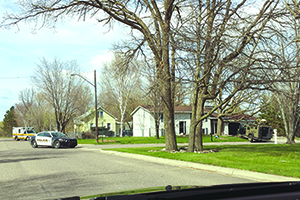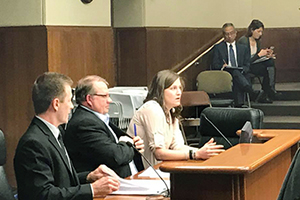By COLLEEN SCHRAPPEN
President Donald Trump deemed the opioid crisis a national emergency last month, but long before that, health care providers in Little Falls, Minn., population roughly 6,900, recognized their community had an opioid problem. In 2014, it is estimated the three local pharmacies were dispensing an average of about 100,000 doses of narcotics each month. Law enforcement reported there were instances when narcotic prescriptions written by CHI St. Gabriel's Health physicians were found at drug-related crime scenes.
"It had been bad for a long time," said Dr. Kurt DeVine, a physician with St. Gabriel's Family Medical Center in Little Falls. "Things were not getting better. In the state, opioid-related emergency room visits had more than doubled since 2012."
By 2014, chronic pain was the number one reason people sought treatment in St. Gabriel's emergency room. In most cases, they were being treated with narcotics as a first-line response. Family practice doctors like DeVine noted a significant increase in drug seeking behavior among patients. It wasn't just physicians who were grappling with the rapidly unfolding epidemic: school districts, social service agencies and pharmacies were feeling the effects of opioid abuse on families and the community.
"Police were probably most vocal about what was going on," DeVine said.

Morrison County Sheriff's Department and Little Falls, Minn., police execute a search warrant May 2 related to alleged trafficking of narcotics in Little Falls. This photo, which first appeared in the Morrison County Record, was taken by a neighbor. (Courtesy of Morrison County Record)
Coordinated response
To mount a coordinated community response to the narcotics problem, in January 2015, the hospital reactivated the Morrison County Prescription Drug Task Force after several years of inactivity. The task force brings together representatives of more than a dozen community agencies. Law enforcement, the Morrison County Public Health department and Morrison County Social Services, pharmacies and the school district are among those represented. To fund the task force initiative to address prescription drug overuse in the county, CHI St. Gabriel's Health Foundation secured a two-year, $370,000 Minnesota Accountable Communities for Health grant, which in a county of 33,000 amounts to a cost of about $5 a head per year. (The grant expired in April 2015, but the hospital is continuing its leadership efforts to counter drug abuse and offering its expertise to other rural communities.)
"Our impetus for bringing community partners to the table was opening the lines of communication to different entities, improving collaboration so we weren't just working in silos," said Ann March, the community and development coordinator at CHI St. Gabriel's Health. "We are all working within a unified vision and mission."
The hospital formed a controlled substance care team that includes DeVine and Dr. Heather Bell, both family practitioners with St. Gabriel's Health Family Medical Center, a nurse navigator, a social worker, pharmacist, and a mental health counselor. They are tasked with helping clinic physicians monitor patients taking narcotics, benzodiazepines or stimulants daily or for the long-term to treat chronic conditions with a goal of addressing patients' pain or distress while decreasing prescriptions of controlled substances. The objective is to reduce prescription abuse through education, modifying or tapering drug dosing when appropriate and delivering care that focuses on the needs of individual patients.
CHI St. Gabriel's Health's three Family Medical Center clinics in Morrison County recently started medication-assisted addiction treatment programs dispensing Suboxone, a drug used to reduce cravings in patients addicted to opioids. Twenty-seven patients are enrolled in Suboxone treatment.
Users, prescribers and sellers
The CHI St. Gabriel's Health approach to the overprescribing problem has three main components: changing the approach to pain management at the three primary care clinics to reduce the number of narcotic prescriptions and meet patients' needs; working with police to reduce street access to prescription narcotics; and preventing new addictions and criminal acts by educating clinicians, the young and the community about the dangers of opioids.

Family Medical Center's Dr. Kurt DeVine, left, and Dr. Heather Bell testify before a Minnesota House committee earlier this year. They flank Rep. Ron Kresha, R-Little Falls, sponsor of a bill to establish opioid abuse prevention pilot projects modeled on a community collaborative approach developed by CHI
St. Gabriel's Health. The bill passed as part of broader legislation in May.
"Our biggest goal is keeping prescription pills from going to the wrong people," said DeVine.
"A lot of guidelines have been changing over the treatment of chronic pain," requiring a shift in prescriber mentality, said DeVine. "The education side is really important."
Minnesota established a prescription drug monitoring system for controlled substances in 2010. Earlier this year, the Minneapolis Star Tribune examined death certificates to determine that despite what it called a "massive decline in doctors prescribing opioid painkillers," the trend line on opioid deaths continues its upward spike as users turn to heroin and other street drugs.
Nevertheless, physicians' heightened awareness of the risk of opioid dependence and addiction has led to a reduction in prescription narcotics, as noted by the Star Tribune. At the CHI St. Gabriel's Health facilities this means patients being treated for conditions such as fibromyalgia or migraines should not routinely receive narcotics for pain. For other chronic pain patients, when appropriate, providers recommend a number of alternatives to help with pain relief, including physical therapy, occupational therapy and massage therapy.
Uphill climb
More than two years in, DeVine takes a pragmatic view of the task force's efforts. "I think it's going to take a long time to see improvement," he said. "Deaths in the state are still going up. Long-term success is still down the road."
The care team found that many patients who had long-running narcotic prescriptions had significant social needs that weren't being met including housing and transportation issues, financial constraints, and mental health problems.
"Sometimes when patients come in and they just need different resources, we're there to put that together," said Kim Moffitt, a mental health coordinator for the care team.
In all, of 453 clinic patients on an active care plan owing to narcotics, benzodiazepines, and stimulants use, 259 have been taken off those drugs completely — a reduction of more than 16,000 drug units (pills, patches or liquids) each month. A local pharmacy that partnered with the task force has reported a 20 percent decrease in narcotic dosage units since the program was implemented two years ago.
March, the community and development coordinator, said the hospital has been awarded a grant from the Minnesota Department of Human Services that will allow its controlled substance care team to use videoconferencing to mentor other rural health systems on the oversight of narcotics prescriptions. "We've also been working with our state legislators to support our project and the development of pilot projects around the state modeled after our program," she said. Those pilot programs are expected to begin sometime in this fiscal year.
Copyright © 2017 by the Catholic Health Association
of the United States
For reprint permission, contact Betty Crosby or call (314) 253-3490.